
Original Link: https://www.anandtech.com/show/2882
Home Servers, Network Storage and the Case House
by Loyd Case on December 2, 2009 12:00 AM EST- Posted in
- Cases/Cooling/PSUs
Here at the Case House, we’re pretty sophisticated home users, as you might imagine. Even if you ignore me, for a moment, there are my two daughters. Elizabeth (now at UCLA) and Emily (who is a sophomore in high school) are both tech savvy users. Elizabeth is best thought of as a power user, particularly when it comes to cell phones and laptops. She’s also a gifted digital photographer and expert Photoshop user (as it applies to photography.)
Emily is more of a power Internet user and gamer. Facebook is always open on her system, as is iTunes. She users her iPod Classic as much for games as for music, and she’s been known to boot up some pretty serious PC games – Titan Quest, Neverwinter Nights 2 and others.
My wife, on the other hand, will tell you she’s not particularly tech savvy. In one sense, she’s right. I had to set up Harmony One universal remote or she would have never figured out the home theater. She still looks to me for basic hardware support, like setting up her work laptop for dual displays whenever she disconnects and reconnects the laptop. In other ways, though, she’s a sophisticated user of tech, building web pages for her company, initiating and managing teleconferencing sites and designing corporate training curricula.
On top of that, we’re all multi-PC users. Elizabeth has both a full featured laptop and netbook. Emily can be found using the communal living room laptop for homework, sometimes more so than the desktop PC in her room.
As for me – I want access to media, music, benchmarking apps, game patches and other useful software from any location in the house. Keeping my PC on 24/7 really isn’t the right answer: network storage is.
What Do You Mean “Network Storage?”
The situation with network storage isn’t as simple as it should be. There exist a spectrum of choices, depending on what you actually need:
- Small, single drive systems that attach to your network and simply become another hard drive to your PC, albeit slower.
- Network attached storage (NAS) devices that offer additional flexibility, including automated backups, USB printer access through the network and some degree of user account control.
- Media savvy NAS boxes that build on basic NAS capability, then add plugin capability. For example, the ReadyNAS from Netgear offers the ability to run a Slimserver plugin, letting you access digital music stored on the server with Logitech SqueezeBox digital media adapters.
- Interesting convergence devices that are both NAS boxes and media servers, like the Mediagate line of hardware, or Western Digital’s WD TV.
- PC based servers. These can range from consumer oriented Windows Home Servers to full on multicore hardware running Windows Server 2003 or one of the many Linux
distros.
- The final solution is cloud storage – something that’s still new to a lot of home users, and exists in multiple implementations and at varying cost structures.
In an ideal world, you’d assess your needs and pick the network storage technology that suits your needs. In the Case House, most of our network storage needs have been ably handled by one of the original ReadyNAS 600 systems, built and sold by Infrant prior to its acquisition by Netgear. The system originally shipped with 1TB of storage (four 250GB drives), set up in RAID 5 mode.
After several years, the oddball paddlewheel cooling fan began to die, so I replaced both the fan and PSU, while simultaneously upgrading the hard drives to four 500GB drives (2TB total, about 1.6TB usable in RAID 5.) The ReadyNAS has since been working fine, humming quietly in the basement lab storage area, giving me no problems and doing its job.
So naturally, I wanted something different.
The X Factor
All we really need around the house is reliable network access, the ReadyNAS would probably run forever – or at least, until it died. But I do like to play with new toys, and I’d been thinking about bringing up a Windows Home Server system for quite a few months.
Of course, you can just buy an off-the-shelf WHS system built by HP or a number of other companies, but that would be too easy. All the PCs in our house were built from the ground up, so I felt compelled to actually build a Windows Home Server system from scratch. Of course, I could have simply taken some of the old PC hardware around here and built up a server from spare parts. That had some attraction, since it would have been fairly inexpensive. It would also have been, in my mind, a somewhat inelegant solution. The smallest power supply I have here is 430W, and even micro ATX cases are bulkier than the ReadyNAS 600.
On the other hand, I’ve had this motherboard for a few months now.
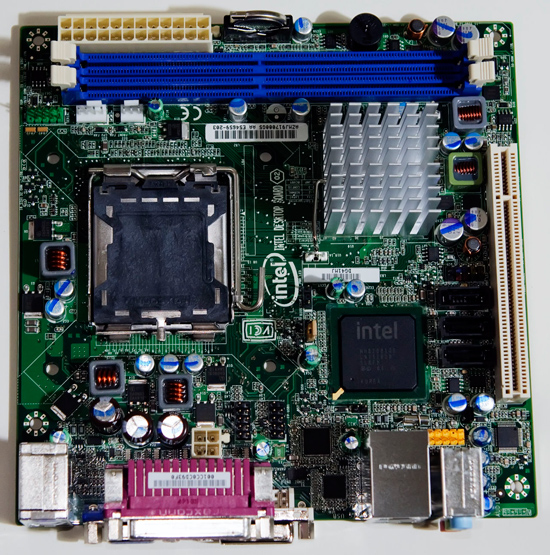
This mini-ITX board is made by Intel, ostensibly for small office or media centric PCs. I never really found a use for it, as most of my applications typically require more graphics horsepower. The Intel DG41MJ board uses the Intel G41 chipset and accepts LGA 775 CPUs (up to 65W TDP.)
Then, one day, I was at my favorite local white box store (Central Computer, in San Jose, CA), and stumbled across this case.
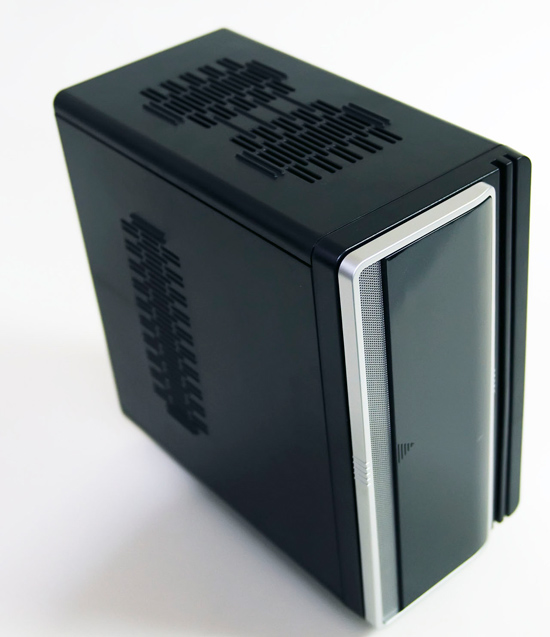
At first, I thought it was just another of many small form factor, slimline cases, ostensibly designed as small Media Center PC cases. But it seemed slightly more bulky than the typical case of that type. The feature list also mentioned “two hot swappable SATA drive bays.” So I slid the front panel open and found that there were, indeed, a pair of hot swappable drive bays.
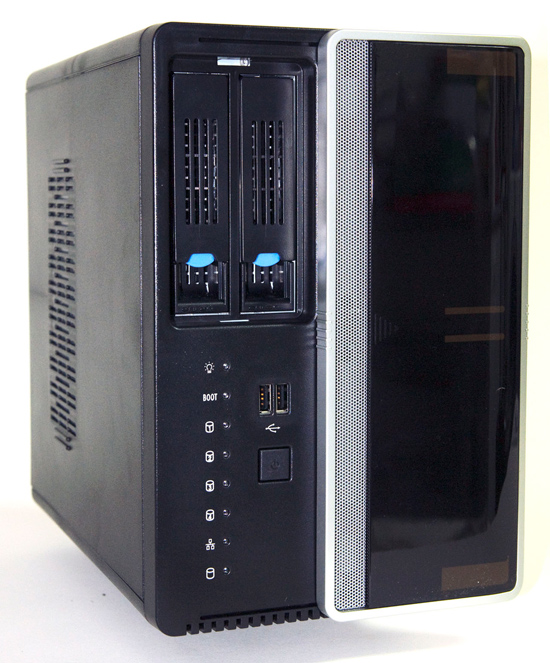
I checked out the specs and discovered that the Chenbro ES32067 is actually a mini-ITX server case. At roughly $120, it ships with a 150W PSU – smaller than the 220W PSU in the ReadyNAS 600. So I bought one.
Some Assembly Required
Once in hand, I had to decide on other parts.
The processor was a conundrum. Given that I was building a Windows Home Server, which has all manner of intriguing add-ins, I wanted some degree of CPU power. On the other hand, dropping $200 or more for a socket 775 Xeon seemed like overkill. So in the end, I picked up a Pentium Dual Core E5200, built on the 45nm Wolfdale die and running at 2.5GHz, for about $64.
Memory was no problem – I had a healthy supply of DDR 800 modules in house, so tossed a pair of 1GB Kingston Value RAM modules into the mix. Storage was a bit more problematic – I’d gotten used to having 2TB on hand. I also wanted to stay within a modest power and thermal envelope. I also happened to have in the lab a pair of WD2002FYPS – the enterprise versions of Western Digitals GreenPower 2TB drives. So in went two of those.
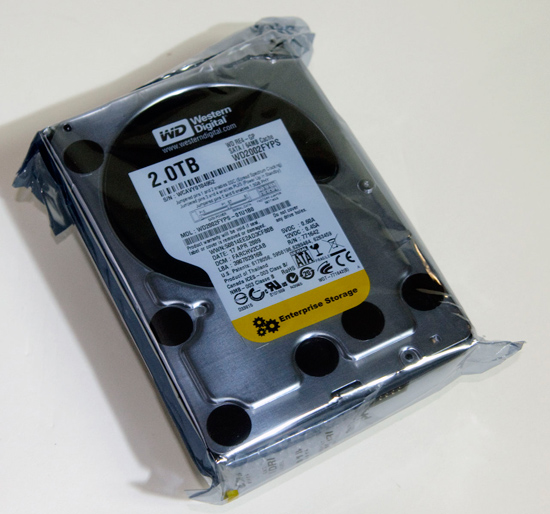
Assembling all the parts into the Chenbro case proved quite straightforward. It’s divided into top and bottom sections, with the motherboard tray in the upper half, and the drive bays and PSU in the bottom half.
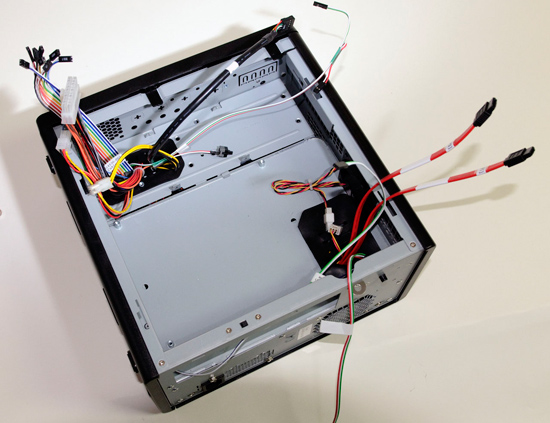
The drives screw into trays, which then slide easily into the drive bays.
Next Up: Software
Installing Windows Home Server requires either a CD drive or bootable USB key. I have a Samsung USB optical drive, so used that to install WHS. If you’ve ever installed Windows XP, the installation process for WHS is pretty straightforward.
All the systems in the basement lab are now running Windows 7 x64-bit versions – most running Home Premium, although I’m running Windows 7 Pro x64 on my production box and Windows 7 Ultimate x64 on the graphics test system.
The Windows Home Server connector software runs fine on Windows 7 (even 64-bit), provided you’ve got at least WHS Power Pack 1 installed. Power Pack 1 also solves the pesky data corruption issue that plagued the release version of WHS.
Later this year, Microsoft will ship Power Pack 3, which will enable better integration with Windows 7, including integration with Windows 7 libraries, better power management settings (such as wake up during backups, or LAN access) and better reliability.
I’ve been running the beta of Power Pack 3 over the past few days, and it’s been working without any issues, but most users should just wait for the final version to ship before installing it.
Postmortem: Nothing’s Perfect
For the time being, I’m planning on running the old ReadyNAS alongside the WHS box for a few weeks. Then I’ll switch over to the Windows Home Server box. After using WHS for a couple of weeks now, it seems much more flexible and, well, shiny, than the old NAS.
That said, no solution is perfect. There are a few gotchas about this particular system I built that I might do a little differently.
There’s the cost issue. Here’s the bill of materials, if you go out and buy all the components:
| Component | Model | Price |
| Case | Chenbro ES32067 | $120 |
| Motherboard | Intel DG41MJ | $80 |
| CPU | Intel E5200 | $64 |
| Memory | 2GB Kingston Value RAMD DDR2-800 | $41 |
| Storage | 2 x WD2002FYPS | $290 each; $580 total |
| Memory | 2GB Kingston Value RAMD DDR2-800 | $41 |
| Operating System | Windows Home Server OEM (SP1) | $85 |
| Total | $970 |
Just the $580 cost of the pair of WD2002FYPS drives could buy you a modest 2TB NAS system. The total cost of $970 is $150 - $300 more than similarly configured, off-the-shelf WHS systems, though many of those are Atom-based. So building your own WHS from scratch may not be a cost effective way to go.
Then there are the technical limitations I encountered.
Take the motherboard, for example. The BIOS setup is pretty limited, even by Intel motherboard standards. One thing I wanted to do was to undervolt and underclock the CPU slightly, to use even less power. But the BIOS doesn’t allow that, even if you enable the infamous “BIOS configuration jumper.”
After I built the system, I discovered that Chenbro actually builds the ES34069 mini-ITX server box with four cold swappable drive bays. That might be more flexible, but it’s also bulkier. The unit also uses an external 120W or 180W PSU brick, rather than a self-contained PSU.
So far, though, the case has been a winner. It’s actually seems quieter than the ReadyNAS, though I haven’t taken SPL measurements. It also fits nicely into the space that was taken up by the ReadyNAS.

Here’s the ReadyNAS in the storage area off the basement lab.

And here’s the Chenbro-based WHS system running. It’s a little taller, but not as wide, as the ReadyNAS, so fits very nicely. If anything, it’s a slightly more efficient use of the available space.
For most users who have modest home networks and simple backup needs, Windows Home Server may be overkill. I’m personally looking forward to the additional flexibility of an actual server, plus I’m also looking forward to experimenting with the various add-ins. So for my purposes, which are not the same as most users by any means, it’s all good.







